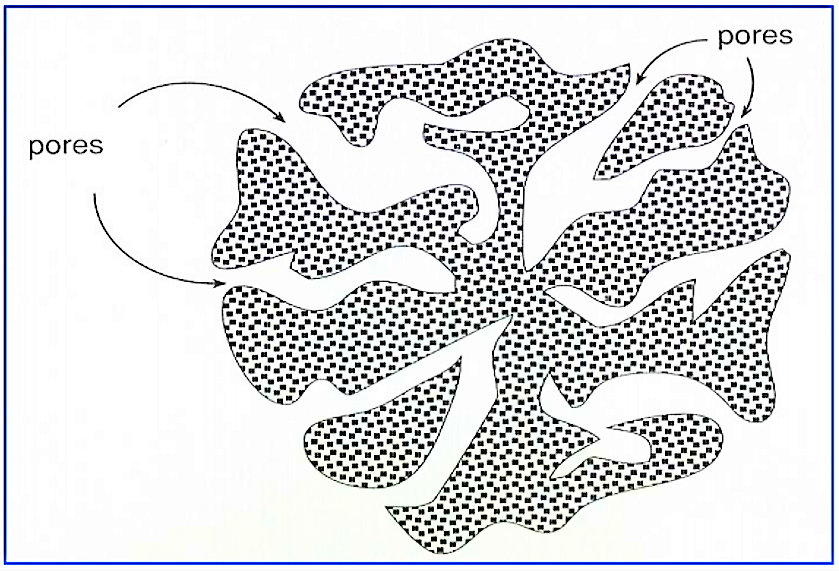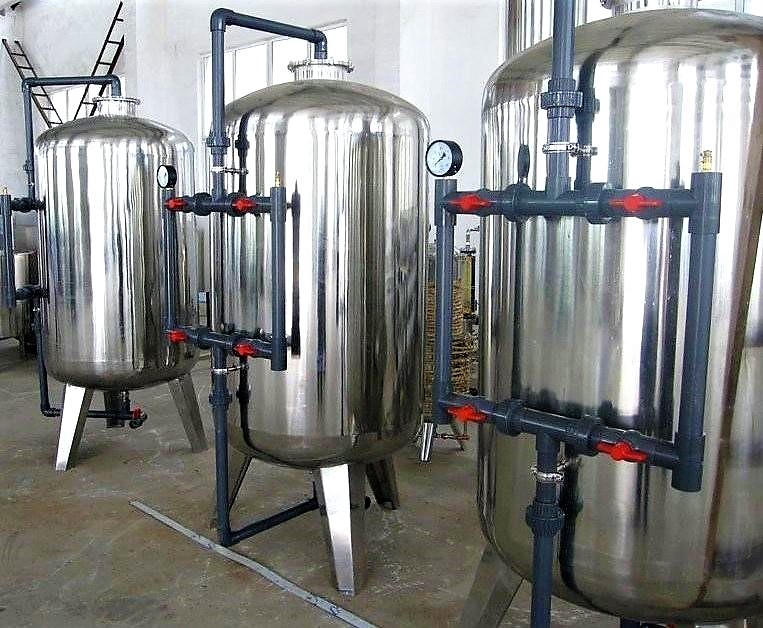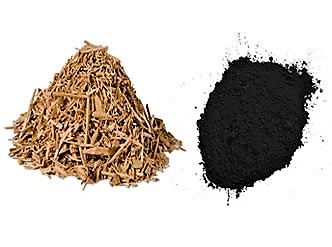Activated carbon filtration is a commonly used technology based on the adsorption of contaminants onto the surface of a filter. This method is effective in removing certain organics (such as unwanted taste and odours, micropollutants), chlorine, fluorine or radon from drinking water or wastewater. However, it is not effective for microbial contaminants, metals, nitrates and other inorganic contaminants. The adsorption efficiency depends on the nature of activated carbon used, the water composition, and operating parameters. There are many types of activated carbon filters that can be designed for household, community and industry requirements. Activated carbon filters are relatively easy to install but require energy and skilled labour and can have high costs due to regular replacement of the filter material.
| In | Out |
|---|---|
Drinking Water, Treated Water |
The use of carbon in the form of charcoal has been used since antiquity for many applications. In Hindu documents dating from 450 BC charcoal filters are mentioned for the treatment of water. Charred wood, bones and coconut charcoals were used during the 18th and 19th century by the sugar industry for decolourising solutions (CECEN 2011). Activated carbon is a material prepared in such a way that it exhibits a high degree of porosity and an extended surface area.

During water filtration through activated carbon, contaminants adhere to the surface of these carbon granules or become trapped in the small pores of the activated carbon (AMIRAULT et al. 2003). This process is called adsorption. Activated carbon filters are efficient to remove certain organics (such as unwanted taste and odours, micropollutants), chlorine, fluorine or radon, from drinking water or wastewater. However, it is not effective for microbial contaminants, metals, nitrates and other inorganic contaminants.Activated carbon filtration is commonly used in centralised treatment plants and at household level, to produce drinking water and in industries to treat effluents. It is also an upcoming treatment applied for the removal of micropollutants both in drinking water production and for the purification of treated wastewater before disposal (see also surface disposal or surface and subsurface groundwater recharge).
(Adapted from LEMLEY et al. 1995)
There are two basic types of water filters: particulate filters and adsorptive/reactive filters. Particulate filters exclude particles by size, and adsorptive/reactive filters contain a material (medium) that either adsorbs or reacts with a contaminant in water. The principles of adsorptive activated carbon filtration are the same as those of any other adsorption material. The contaminant is attracted to and held (adsorbed) on the surface of the carbon particles. The characteristics of the carbon material (particle and pore size, surface area, surface chemistry, etc.) influence the efficiency of adsorption.

The characteristics of the chemical contaminant are also important. Compounds that are less water-soluble are more likely to be adsorbed to a solid. A second characteristic is the affinity that a given contaminant has with the carbon surface. This affinity depends on the charge and is higher for molecules possessing less charge. If several compounds are present in the water, strong adsorbers will attach to the carbon in greater quantity than those with weak adsorbing ability.
(Adapted from DROVAC and SKIPTON 2008)
The medium for an activated carbon filter is typically petroleum coke, bituminous coal, lignite, wood products, coconut shell or peanut shell. The carbon medium is “activated” by subjecting it to stream (a gas like water, argon or nitrogen) and high temperature (800-1000°C) usually without oxygen. In some cases, the carbon may also undergo an acidic wash or be coated with a compound to enhance the removal of specific contaminants. The activation produces carbon with many pores and a high specific surface area. It is then crushed to produce a granular or pulverised carbon product.

(Adapted from DROVAC and SKIPTON 2008)
Activated carbon units are commonly used to remove organics (odours, micropollutants) from drinking water at centralised and decentralised level. At centralised level, they are generally part of one of the last steps, before the water is fed into the water distribution network. At decentralised level, activated carbon filtration units can either be point-of-use (POU) or point-of-entry (POE) treatment.
A POE device is recommended for the treatment of radon and volatile organic compounds because these contaminants can easily vaporise from water in showers or washing machines and expose users to health hazards. POU devices are useful for the removal of lead and chlorine. The structure of POU devices can either be in-line, line-bypass faucet mounted (see also advanced filters) or pour-through (similar to the design of ceramic candles, colloidal silver or biosand filters).

Activated carbon filters can also be used as a tertiary treatment in wastewater treatment plants to remove micropollutants from municipal effluents or recalcitrant contaminants from industrial effluents.
Activated carbon is often used as pre-treatment to protect other water treatment units such as reverse osmosis membranes and ion exchange resins from possible damage due to oxidation or organic fouling. The combination of ozonation with activated carbon is a very efficient technique for eliminating organic matter including micropollutants. Besides, the lifetime of activated carbon filters is extended drastically when used in combination with ozone, deceasing operation costs substantially (AEPPLI and DYER-SMITH 1996).
(Adapted from AMIRAULT et al. 2003)
Installation costs are moderate but additional technical equipment is required. Operating costs are usually limited to filter replacement. Depending on the type and concentration of the contaminant being removed, some carbon filters may require special hazardous waste handling and disposal, which can be costly.
(Adapted from LEMLEY et al. 1995)
Carbon filters are relatively easy to install and maintain but skilled labour is required at least occasionally for monitoring the removal performance over time of both POU and POE equipment. Activated carbon filters have a limited lifetime. After long-term use, their surfaces are saturated with adsorbed pollutants and no further purification occurs. The filter material therefore has to be replaced at regular intervals, according to manufacturer's instructions. Replacement intervals should be calculated based on the average daily water use through the filter and the amount of contaminant being removed. Cartridge disposal depends on usage. A carbon cartridge can be backwashed and then reused or discarded if non-toxics have been adsorbed.
| Working principle | The pollutants are removed from water through adsorption on the surface of the activated carbon. Use at the POE or POU (e.g. advanced filters). |
| Capacity/adequacy | Simple technique using abundant raw material (e.g. petroleum coke, bituminous coal, lignite, wood products, coconut shell or peanut shell). Skilled labour required at least occasionally. |
| Performance | Efficient for pollutant having high affinity with activated carbon surface (non-polar compounds). |
| Costs | Relatively low operation costs. |
| Self-help compatibility | Initial analysis of water is required to choose proper adsorbent (type of activated carbon). |
| O&M | Regular replacement or regeneration of carbon cartridge. |
| Reliability | Reliable if the water composition is taken into account when choosing the type of activated carbon used as filter material. |
| Main strength | Activated carbon can be produced relatively easily everywhere in the world. |
| Main weakness | Filter has to be replaced on a regular basis. |
Activated carbon filters are widely used to produce drinking water at household and community level (to remove certain organics, chlorine or radon from drinking water) and to treat industrial or municipal wastewaters. It is not efficient for disinfection and nitrates removal. Adsorption on activated carbon is a simple technology based on materials such as fossil fuels (petroleum coke, lignite...) and even agricultural waste (e.g. coconut shell, wood, etc.).
To choose the most applicable type of activated carbon for a given application it is important to analyse the composition of the influent water previously. The carbon filter has to be replaced or regenerated regularly to remain efficient. Activated carbon can also be used as a pre-treatment to protect other water treatment units.
Ozonation and Granular Activated Carbon Filtration the Solution to Many Problems
Activated Carbon Treatment of Drinking Water Supplies
This 4 pages factsheet focuses on the use of activated carbon treatment for drinking water with a special emphasis on practical considerations (type of units, certification etc.)
AMIRAULT, R., CHOBANIAN, G., MCCANTS, D., MCCANN, A., BURDETT, H. and NEPTIN, B. (2003): Activated Carbon Treatment of Drinking Water Supplies. In: Healthy Drinking Water for Rhode Islanders: URL [Accessed: 21.05.2019]Water and Wastewater Treatment: Historical Perspective of Activated Carbon Adsorption and its Integration with Biological Processes
Drinking Water treatment: Activated Carbon
Water Treatment System (Active Carbon Filter)
Wood based Powder Activated Carbon
Activated Carbon Treatment of Drinking Water
Activated carbon filtration (AC) is effective in reducing certain organic chemicals and chlorine in water. It can also reduce the quantity of lead in water although most lead-reducing systems use another filter medium in addition to carbon. Water is passed through granular or block carbon material to reduce toxic compounds as well as harmless taste- and odor-producing chemicals. This fact sheet discusses the principles and processes of typical activated carbon filtration systems.
LEMLEY, A. ; WAGENET, L. ; KNEEN, B. (1995): Activated Carbon Treatment of Drinking Water. In: Water Treatment Notes Cornell Cooperative Extension: URL [Accessed: 04.10.2011]Adsorption and Treatment of Organic Contaminants using Activated Carbon from Waste Nigerian Bamboo
The treatment of organic contaminants using activated carbon from Nigerian waste bamboo is investigated in this article.
ADEMILUYI, F. T. ; AMADI, S. A. ; AMAKAMA, N. J. (2009): Adsorption and Treatment of Organic Contaminants using Activated Carbon from Waste Nigerian Bamboo. In: Journal of Applied Sciences and Environmental Management: Volume 13 , 39-47 . URL [Accessed: 04.10.2011]Granular Activated Carbon Management at a Water Treatment Plant
This document contains a literature review on activated carbon and reports the results of a detailed study of granular activated carbon management at the Rietvlei Water treatment plant in South Africa.
CLEMENTS, M. (2002): Granular Activated Carbon Management at a Water Treatment Plant. [Accessed: 04.10.2011] PDFHome Water Treatment Using Activated Carbon
This 5 pages factsheet summarises important facts that have to be considered for home water treatment by means of activated carbon.
COOPERATIVE EXTENSION SERVICE MICHIGAN STATE UNIVERSITY (1990): Home Water Treatment Using Activated Carbon. In: (New) Extension Bulletin : URL [Accessed: 04.10.2011]Activated Carbon Filtration
This publication discusses the effects of pH, temperature, flow rate, contaminant nature, activated carbon type etc. on adsorption.
DESILVA, F. (2000): Activated Carbon Filtration. In: Water Quality Products Magazine : URL [Accessed: 21.05.2019]Effect of Point-of-Use, Activated Carbon Filters on the Bacteriological Quality of Rural Groundwater Supplies
This paper is a field study discussing the water quality of domestic groundwater supplies treated with point of use powered activated carbon filters with an emphasis on the impact of such treatment on bacteriological quality.
SYNDER, J.W. ; MAINS, C.N. ; ANDERSON, R.E. ; BISSONETTE, G.K. (1995): Effect of Point-of-Use, Activated Carbon Filters on the Bacteriological Quality of Rural Groundwater Supplies. In: Applied and Environmental Microbiology: Volume 61 , 4291-4295. URL [Accessed: 04.11.2011]Organic Removal
In this 4 pages factsheet, the performances and limitations of organic removal by activated carbon are discussed with a special emphasis on air stripping systems.
TECH BRIEF (1997): Organic Removal. In: National Drinking Water Clearhouse : URL [Accessed: 04.10.2011]Industrial Wastewater Treatment Using Natural Material as Adsorbent
This paper shows a comparison between coconut shell-based and commercial activated carbons with respect to adsorption of organic matter from industrial wastewater in Africa.
AMUDA, O.S. ; IBRAHIM, A.O. (2006): Industrial Wastewater Treatment Using Natural Material as Adsorbent. In: African Journal of Biotechnology : Volume 5 , 1483-1487. URL [Accessed: 05.10.2011]Traitement des Micropolluants dans les Eaux Uses-Rapport Final sur les Essais Pilotes a la STEP de Vidy (Lausanne)
This document presents the results of a pilot study aiming at removing water micropollutants at the Lausanne (Switzerland) wastewater treatment plant.
MARGOT, J. ; MAGNET, A. ; THONNEY, D. ; CHEVRE, N. ; ALENCASTRO, F. de ; ROSSI, L. (2011): Traitement des Micropolluants dans les Eaux Uses-Rapport Final sur les Essais Pilotes a la STEP de Vidy (Lausanne). In: Ed. Ville de Lausanne : URL [Accessed: 21.05.2019]Using Biological Activated Carbon in Drinking Water Treatment
This presentation describes the coupling of ozonation and activated carbon filtration for Fresno (USA) surface water treatment facility.
MARTIN, L. MOORHEAD, R. HEARDS, K. PROCE, D. (n.y): Using Biological Activated Carbon in Drinking Water Treatment . [Accessed: 04.10.2011] PDFSmall Community Water supplies: Technologies for Fluorine Removal - Chapter 22
This document presents several methods for the removal of fluoride from water in small communities. One section is dedicated to bone char as a defluoridating material.
SMET, J. ; WIJK, C. van (2002): Small Community Water supplies: Technologies for Fluorine Removal - Chapter 22. In: SamSam Water Library: URL [Accessed: 08.11.2011]Adsorption with Granular Activated Carbon (GAC)
This presentation given in a course at the New Jersey Institute of Technology gives a theoretical and technical overview of adsorption on granular activated carbon.
ARMENANTE, P.M. (n.y): Adsorption with Granular Activated Carbon (GAC) . URL [Accessed: 21.05.2019]Activated Carbon Treatment of Drinking Water Supplies
This 4 pages factsheet focuses on the use of activated carbon treatment for drinking water with a special emphasis on practical considerations (type of units, certification etc.)
AMIRAULT, R., CHOBANIAN, G., MCCANTS, D., MCCANN, A., BURDETT, H. and NEPTIN, B. (2003): Activated Carbon Treatment of Drinking Water Supplies. In: Healthy Drinking Water for Rhode Islanders: URL [Accessed: 21.05.2019]Guidelines for Drinking-water Quality
Chemical methods of water treatment including activated carbon from the World Health Organization.
What Is Activated Charcoal and How Does it Work?
A short summary of activated charcoal and its functioning in water treatment.
Coconut Shell Based Products
Product specification of activated carbon from Coconut Shell Based Products in India.



